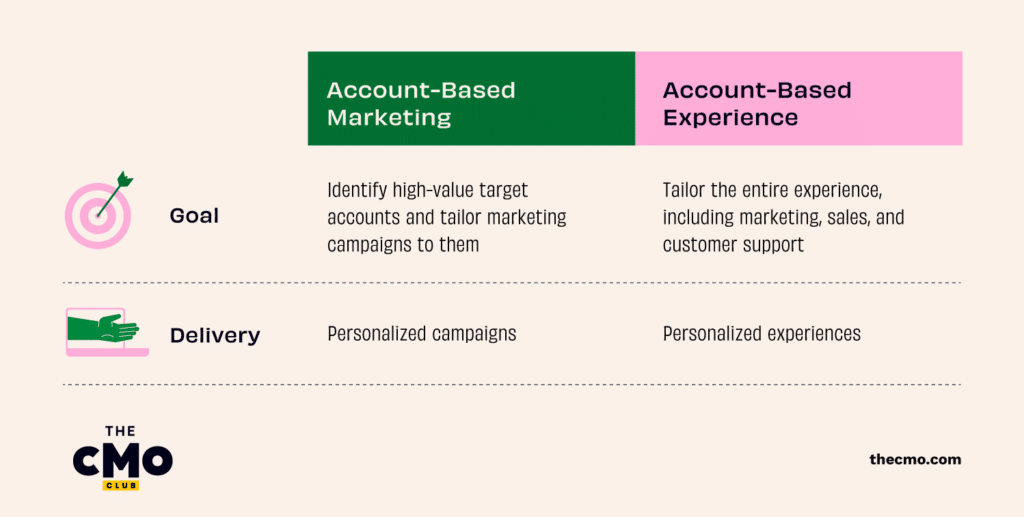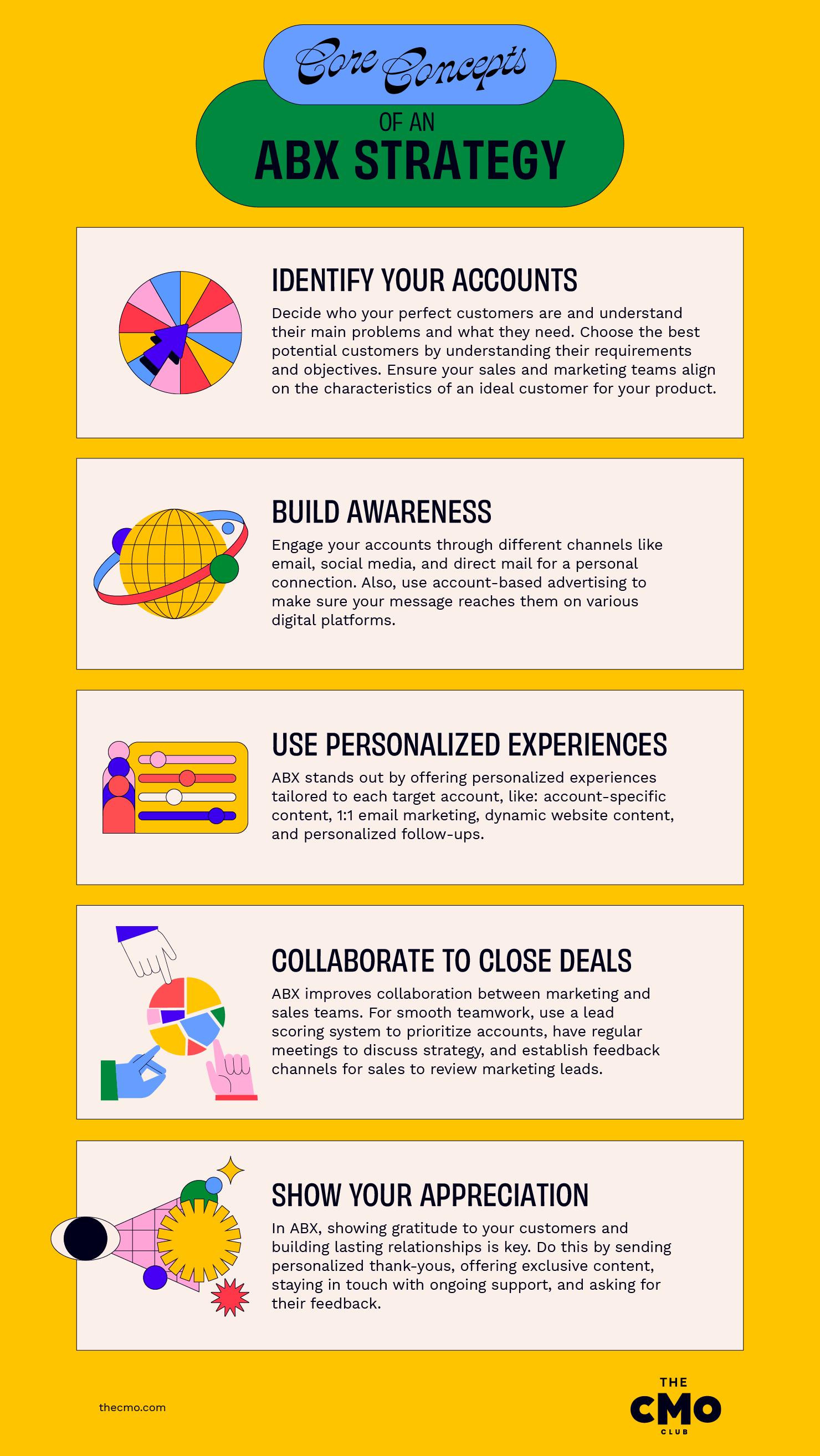For years, the importance of account-based marketing (ABM)—the focused targeting of high-value accounts through personalized campaigns—was beaten into our skulls one blog, tweet, and thought leadership article at a time. Now, companies are using account-based experience (ABX) to take things one step further by applying the personalized approach to the entire buyer journey.
If you’ve already implemented ABM tactics and enjoy the results coming through, ABX is a natural next step. However, because this approach requires cross-departmental collaboration, it’s essential to have the right systems in place to align your teams. In this article, I'll share everything I know to help.
What Is Account-Based Experience (ABX)?
Account-based experience (ABX) is a GTM strategy focused on providing tailored customer experiences for target accounts. From awareness through to post-sale, ABX seeks to personalize every touchpoint in the B2B buyer journey.
Due to this focus on the entire buyer journey, ABX strategies require collaboration between marketing, sales and customer support. Instead of treating these functions as separate entities, a unified approach is adopted to maintain a high level of personalization throughout the buying process.

ABM vs ABX: What’s the difference?
The ABM vs ABX debate is similar to the debate of outbound vs. inbound sales. Account-based marketing (ABM) focuses on identifying high-value target accounts and tailoring marketing campaigns specifically to those accounts. The goal is to attract and engage only the most relevant audience in order to maximize ROI. There is some great account-based marketing software for this.
Similarly, account-based experience (ABX) delivers tailored experiences to target accounts, however, it focuses on the combined efforts of marketing, sales and customer support. This is a major reason why ABX can be a great strategy if you are focused on improving the customer experience, one of the many top priorities for CMOs in 2024.
One of the primary challenges of account-based marketing is that it requires alignment with sales to have the strongest impact, but this is often not the case. ABX was created in response to this challenge. Both strategies can improve your overall B2B marketing strategy. You only need to ensure your chosen program suits your needs at that point in time.
A visual example

ABX vs CX: How does it relate?
Account-based experience (ABX) is essentially a specialized branch of the broader concept of customer experience (CX). The key difference is in the customer segments considered by each approach.
ABX takes the core principles of successful CX, including trust, empathy, and relevance at every stage of the customer journey, and applies them within the context of targeted accounts. CX, on the other hand, considers the collective experiences of all customers, not just a select few.
Why Is ABX Important In B2B Marketing?
Put simply, account-based experience (ABX) prioritizes quality over quantity, and drives better returns as a result, which is why some marketers say its among their top five marketing strategies.
This is thanks to its focus on building strong, lasting customer relationships in addition to qualified lead generation.
Here are some supporting statistics showcasing the value of ABX:
- Businesses that invest in their customer experience are shown to grow revenue 40% faster, while also improving customer retention by 70%, according to DemandBase.
- When we get personal with our marketing, particularly our content, customer stakeholders are 40% more likely to make a buying decision, according to Harvard Business Review.
- According to insights by Strategic ABM, 76% of businesses engaged in ABM struggle to align their sales and marketing teams. ABX can solve this.
Core Concepts Of An ABX Strategy
Account-based experience isn't your typical demand generation—instead, you’re creating a custom buying journey for specific accounts. This requires unification of your marketing and sales actions, while also leveraging your customer success teams to support customer relationships.

Identify your accounts
Similar to when creating a strategy for account-based marketing, the first step in ABX is to define your ideal accounts, and consider what their pain points, interests and needs are.
Remember, ABX goes beyond targeting high-value accounts—you’re elevating the customer experience for entire buying committees, rather than single stakeholders. This is necessary to deepen relationships and increase retention.
For this, you must consider each member of a customer buying team. Then, pinpoint the unifying pain points, challenges, and goals of the buying team.
- Account Selection: Identify high-potential accounts that are a perfect fit for your product or service. Research their pain points, goals, and challenges.
- Define Ideal Customer Profiles (ICPs): Work with your sales teams to refine your ICPs, ensuring that marketing and sales are on the same page about the characteristics of a perfect-fit customer.
Build awareness
The next step in your ABX strategy is to build awareness within your target accounts. Instead of casting a wide net, you concentrate your resources on a select group of accounts that align with your ideal customer profile. Here's how to effectively build awareness:
- Multi-Channel Engagement: Use a mix of marketing channels to reach your accounts, including email marketing, social media, and even direct mail for a personal touch.
- Account-Based Advertising: Invest in account-based advertising to ensure your target accounts see your message across various digital marketing platforms.
Use personalized experiences
One of the defining features of ABX is its emphasis on personalized experiences for target account selling. This is where the true power of ABX shines:
- Account-Specific Content: Develop content that speaks directly to the challenges and goals of each account. This can include case studies, whitepapers, and webinars tailored to their industry and needs.
- 1:1 Email Marketing: Craft personalized email campaigns that address the recipient by name and speak to their specific pain points.
- Dynamic Website Content: Use website personalization tools to show different content to visitors from your target accounts arriving to your ABM landing pages, ensuring a relevant and engaging experience.
- Personalized Follow-Ups: After an initial interaction, follow up with content or offers that align with the account's previous engagement with your brand.
Collaborate to close deals
ABX fosters strong collaboration between marketing and sales teams, aligning efforts to drive conversions. Here's how to ensure seamless collaboration:
- Lead Scoring: Develop a lead scoring system to prioritize accounts based on their engagement and fit with your offerings.
- Regular Communication: Schedule regular meetings to discuss account progress and strategies for moving them through the sales funnel.
- Feedback Loops: Establish feedback mechanisms for sales to provide insights on the quality of leads generated by marketing.
Show your appreciation
Appreciating your customers and fostering long-term relationships is a crucial aspect of ABX. Here are ways to show your appreciation:
- Personalized Thank-You Notes: Send personalized thank-you notes or gifts to accounts that have made a purchase or reached a significant milestone in their journey with your company.
- Exclusive Content: Provide exclusive content or offers to loyal customers, demonstrating that you value their business.
- Continuous Engagement: Stay engaged with your customers even after the sale, offering ongoing support, and valuable resources.
- Feedback Collection: Solicit feedback from customers to show that their opinions matter and to identify areas for improvement.
Best Practices To Do ABX Right
Collect robust customer data
Effective ABX relies on data-driven decision-making. Gather comprehensive data through digital marketing software to learn about your target accounts, including their pain points, preferences, and past interactions with your brand.
Paraphrasing Josh Thomas, VP of Madison Logic, effective ABM strategies create a clear picture of their accounts and buying committees through a combination of several sources:
- Buyer research activity
- Technographic install base data
- Historical engagement data for related solutions.
Measurement and optimization
Use key performance indicators (KPIs) to track the success of your ABX efforts. Analyze ABM metrics like engagement, conversion rates, and revenue generated from target accounts. Regularly optimize your strategy based on the data.
Align with sales
Strong alignment between your marketing and sales teams is crucial. Collaboratively define your ideal customer profile (ICP) and establish clear communication channels to share insights and feedback throughout the ABX process.
Use the right tools
- Demandbase helps marketers identify high-value accounts, personalize experiences, and monitor progress. It also facilitates seamless integration with popular CRM and marketing automation systems, improving data exchange and alignment between teams.
- 6sense is a predictive intelligence platform specializing in sales and marketing. It harnesses artificial intelligence (AI) to help businesses pinpoint and engage their ideal customers. 6sense provides a range of ABX-focused features, including account identification, intent data, personalized content creation, and engagement analytics.
- Terminus is a comprehensive ABX platform designed to assist marketers in identifying and prioritizing target accounts, crafting personalized content and campaigns, and assessing account engagement. With its suite of tools, Terminus streamlines various ABX-related tasks and offers valuable insights for data-informed decision-making.
Create Amazing Experiences
The journey from traditional marketing to account-based marketing (ABM) has been transformative. However, the evolution doesn't stop there.
Account-based experience (ABX) takes your ABM strategy a step further by focusing on the entire customer journey. As we've seen, ABX isn't just about marketing or the creative ideas for your ABM campaigns, but involves a holistic approach that integrates marketing, sales, and customer support teams.
It's about creating a tailored and unified experience at every touchpoint in the B2B buyer journey, ensuring that every interaction is personalized and meaningful. By aligning these departments and focusing on customer-centricity, ABX has proven to drive better returns, improved customer satisfaction, and sustainable revenue growth.
Like what you read in this article? Then sign-up for The CMO newsletter! You'll get the best tips and insights to stay at the forefront of marketing innovation.


